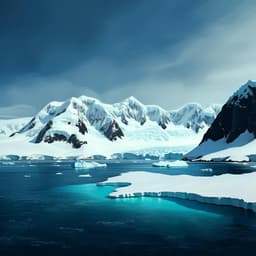
Earth Sciences
Enhanced Arctic sea ice melting controlled by larger heat discharge of mid-Holocene rivers
J. Dong, X. Shi, et al.
This research reveals the significant influence of Russian pan-Arctic river heat discharge on Arctic sea ice loss, highlighting the interplay between solar insolation and regional albedo changes. Conducted by a team of experts including Jiang Dong and Xuefa Shi, this study uncovers how intensified heat contributions have accelerated summer sea ice melting amidst global warming.
~3 min • Beginner • English
Introduction
Arctic sea ice has dramatically declined under global warming, with feedbacks accelerating ongoing warming. Yet future climate trends tied to sea-ice melting remain uncertain due to incomplete understanding of the mechanisms responsible for sea-ice retreat or potential future summer sea-ice absence. Paleoclimate analogs from warmer intervals, especially the mid-Holocene (MH), can inform future projections. Prior work attributes Holocene Arctic sea-ice changes to variations in solar insolation, poleward moisture transport and latent heat, and Atlantic and Pacific warm-water inflows. Limited instrumental records and one numerical simulation have suggested that pan-Arctic rivers deliver heat to the Arctic Ocean via discharge of seasonally warmed waters, potentially contributing to sea-ice loss. Modern early-summer river thermal flux can be sourced from high and mid-latitudes and is on the order of ~10% of the combined Atlantic and Pacific oceanic heat inputs. The study investigates whether enhanced MH early-summer insolation amplified river heat discharge, thereby intensifying Arctic sea-ice retreat, focusing on the East Siberian Arctic Shelf (ESAS) where river influence and sea-ice seasonality are pronounced.
Literature Review
Previous studies link Holocene Arctic sea-ice variability to orbital-scale solar insolation forcing, increased poleward moisture and latent heat transport, and inflows of relatively warm Atlantic and Pacific waters. Instrumental observations and a numerical model indicate that, in recent decades, pan-Arctic rivers have transported significant thermal energy to the Arctic Ocean, with early-summer river thermal fluxes collectively approximating 10% of the Atlantic and Pacific heat inflow combined. The ESAS region, characterized by strong seasonality in sea-ice cover and substantial influence from Russian rivers (e.g., Lena, Indigirka, Kolyma), serves as a key area to evaluate riverine thermal impacts. Modern observations show that early-summer solar insolation increases river water temperatures and runoff via snow/ice and permafrost thaw and increased precipitation. Prior biomarker and paleoceanographic studies document less MH summer sea ice and warmer conditions in the Arctic, but the specific mechanism linking higher MH insolation, river heat discharge, and sea-ice loss had not been fully examined.
Methodology
- Study area and proxy rationale: Focus on the East Siberian Arctic Shelf (ESAS; Laptev, East Siberian, and Chukchi shelf shallower than ~100 m), which receives large volumes of warm, buoyant freshwater from Russian pan-Arctic rivers and exhibits strong sea-ice seasonality. Sedimentation rate is used as a proxy for river discharge/thermal flux (jointly governed by runoff and freshwater temperature) because most sediment input occurs in early summer when insolation is at a maximum.
- Core collection and materials: Two gravity cores collected during cruise LV77 (Aug–Sep 2016) using R/V Akademik Lavrentiev: LV77-36-1 (155.66°E, 74.10°N; 36 m water depth; 376 cm; ~8.2 ka) and LV77-41-1 (154.12°E, 72.55°N; 24 m; 254 cm; ~7.0 ka). Sediments consist mainly of ash-black/dark-grayish clayey silt; scarce bivalve shells. LV77-41-1 is persistently influenced by Indigirka River discharge; LV77-36-1 reflects broader ESAS conditions.
- Provenance control: Rare earth element (REE) data, surface clay minerals, carbon isotopes, and terrigenous biomarkers indicate stable sediment sources predominantly from adjacent Siberian rivers (notably Indigirka), ensuring that sedimentation rate variations reflect riverine inputs rather than changing provenance.
- Sea-ice proxy: Ice-rafted debris (IRD) quantified as sand fraction >63 µm (%) to reconstruct sea-ice presence/export. Additional regional biomarker and micropaleontological records were compiled to constrain sea-ice conditions.
- Sedimentation rate proxy: Age-depth models constructed to derive sedimentation rates in both cores; supplemented with compiled ESAS shelf sedimentation-rate datasets from river-influenced areas to represent river discharge magnitude.
- Geochronology: Combined accelerator mass spectrometry radiocarbon (14C) dating of bivalve shells (12 dates for LV77-36-1; 3 for LV77-41-1) and optically stimulated luminescence (OSL) dating of quartz (7 for LV77-36-1; 10 for LV77-41-1). 14C calibrated with Calib 8.2 using Marine13 curve and ΔR=53±67 years (Laptev Sea). Interpolations and 2σ uncertainties computed with Clam (R). OSL measurements on 4–11 µm quartz using Risø DA-20; luminescence protocols specified; U, Th (ICP-MS), K (ICP-OES), and water content assessed with ±5% error. Recognizing systematic OSL age overestimation due to inadequate bleaching in river-transported fine silt, a high-confidence polynomial recalibration was derived from linear correlations between OSL and 14C ages, reducing max differences to 0.6 ka and mean to ~0.
- Data synthesis: Compiled published MH–LH records of sedimentation rates, sea-ice biomarkers and microfossils, inland temperature/precipitation proxies, and instrumental datasets (surface air temperature, river water temperature, runoff, precipitation) for pan-Arctic rivers and ESAS (primarily 1948–1994) to examine relationships among insolation, hydroclimate, river discharge/heat, and sea ice.
- Sea level context: Considered Holocene sea-level reconstructions to minimize coastal proximity effects; focus on 7.5–0 ka when shoreline position was relatively stable in the study area.
Key Findings
- Mid-Holocene (MH; 7.5–4.0 ka) experienced significantly reduced early-summer Arctic sea ice on the ESAS relative to the Late Holocene (LH; 4.0–0 ka), evidenced by lower IRD in MH and increased regional sea-ice biomarkers and external records showing stronger sea-ice conditions in LH.
- Sedimentation rates (proxy for river discharge/thermal flux) were substantially higher in MH than LH, indicating larger Russian pan-Arctic river inputs during MH. Mean sedimentation rates: MH 63.1 cm/ka (LV77-36-1) and 75.4 cm/ka (LV77-41-1) versus LH 22.7 cm/ka and 36.7 cm/ka, respectively.
- Modern climatology and instrumental data show early-summer (June–July) peaks in river runoff, water temperature, and thermal flux; freshwater temperature and runoff positively correlate with surface air temperature and basin precipitation. Approximately 74.5% of annual suspended sediment is delivered in early summer (AD 1935–2013), underscoring seasonal concentration of riverine inputs.
- Enhanced MH early-summer insolation at high northern latitudes raised regional air temperatures (by roughly 1–3 °C relative to LH, from multiproxy syntheses), deepened permafrost active layers, increased snow/ice melt and precipitation, and thus increased river runoff and likely higher freshwater temperatures—together amplifying river heat discharge.
- River heat discharge, though modest compared with oceanic inflows, can be climatically relevant: modern early-summer pan-Arctic river thermal flux is ~10% of the combined Atlantic and Pacific oceanic heat input, and in MH this contribution was larger due to higher insolation/warming.
- Mechanistically, enhanced early-summer river heat advected under and around floes promoted initial sea-ice melt and warming of surface waters, lowering albedo and increasing absorption of solar energy, reinforcing further melt through summer.
- Atlantic and Pacific inflows exhibited broadly comparable MH–LH states at millennial scales; their seasonal timing (winter peak upward heat release from Atlantic water; late-summer intensification of Pacific inflow) suggests a lesser role in early-summer melt compared to river heat discharge.
- Evidence of lowered surface salinities and freshwater biota on the ESAS during MH supports strong river influence and stratification consistent with enhanced freshwater inputs.
Discussion
Findings indicate that early-summer (June–July) solar insolation was a principal driver of MH-to-LH sea-ice evolution by two pathways: direct radiative forcing and, critically, indirect amplification via increased riverine heat discharge. During MH, strengthened insolation warmed air and land surfaces, intensified permafrost and snow/ice thaw, and increased precipitation, boosting river runoff and freshwater temperatures. The resulting larger river heat flux promoted early-summer sea-ice retreat on the ESAS, preconditioning the ocean surface for further seasonal melt through reduced albedo and enhanced solar absorption. This positive feedback led to warmer surface waters and expanded seasonal ice-free areas. The stabilizing effect of low-salinity surface layers would inhibit upward heat release from deeper Atlantic/Pacific waters during summer, emphasizing the seasonal lead of river heat in initiating melt. In contrast, Atlantic and Pacific subsurface heat contributions peak later (winter and late summer/early autumn, respectively), aligning poorly with the timing of maximum early-summer insolation. The coherence between decreasing early-summer insolation since MH and reconstructed growth of sea ice into the LH underscores the dominant seasonal control. Collectively, these mechanisms reveal that riverine heat discharge is an important and previously underappreciated factor in Holocene Arctic sea-ice dynamics and is relevant to future warming scenarios.
Conclusion
This study reconstructs Holocene ESAS sea-ice conditions and Russian pan-Arctic river heat discharge using IRD and sedimentation-rate proxies constrained by robust age models and provenance checks. It demonstrates that enhanced early-summer insolation during the mid-Holocene increased river runoff and freshwater temperatures, amplifying riverine heat discharge and contributing substantially to early-summer sea-ice loss via albedo feedbacks. Atlantic and Pacific inflow histories appear broadly comparable between MH and LH on millennial scales, highlighting the distinctive seasonal role of river heat in initiating melt. The results underscore an important land–ocean coupling—permafrost thaw, warming runoff, and river heat—that can reinforce summer sea-ice decline, a process not fully represented in many climate models. Future research should quantify basin-scale river heat impacts across the Arctic shelves, resolve spatial heterogeneity in river–ice coupling, develop direct paleothermometry for river waters, and incorporate these mechanisms into Earth system models to improve projections of summer sea-ice trajectories under continued warming.
Limitations
- Direct reconstructions of Holocene river water temperatures are lacking; inferences rely on correlations with air temperature and multiproxy summer temperature reconstructions.
- OSL dating of fine quartz is susceptible to age overestimation due to inadequate bleaching during rapid river transport; authors applied a polynomial recalibration anchored to 14C ages, but residual uncertainties remain.
- Sedimentation rate as a proxy for river discharge/thermal flux can be influenced by additional factors (e.g., changes in sediment supply, coastal morphology, sea level), though shoreline positions were relatively stable since MH in the study area and provenance analyses support river dominance.
- Spatial heterogeneity: Conclusions are strongest for the ESAS and may not uniformly extend across all Arctic shelves; basin-wide impacts require further study.
- Potential confounding from Atlantic and Pacific inflow variability is mitigated by evidence of broadly comparable MH–LH states and mismatched seasonal timing, but local variations could affect specific regions.
- Instrumental datasets used to assess modern relationships (1948–1994) may be affected by damming, permafrost thaw effects on water temperature, and regional precipitation variability due to topography.
Related Publications
Explore these studies to deepen your understanding of the subject.







